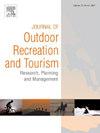野化与森林娱乐价值:大型食草动物与围栏对自然管理影响的选择实验分析
IF 4.4
3区 管理学
Q1 HOSPITALITY, LEISURE, SPORT & TOURISM
Journal of Outdoor Recreation and Tourism-Research Planning and Management
Pub Date : 2025-09-03
DOI:10.1016/j.jort.2025.100934
引用次数: 0
摘要
大型食草动物的放牧和浏览越来越多地被用作促进生物多样性的管理工具。虽然研究已经探讨了它们对生态的影响,但很少有人关注它们对自然地区的娱乐价值的影响。鉴于户外娱乐对社会福利的重要性,了解大型食草动物的存在如何影响休闲主义者以及是否可以减轻潜在的负面影响至关重要。在丹麦近2900名受访者的离散选择实验中,我们调查了草食动物和围栏的存在对森林娱乐价值的影响。基于多项和混合logit模型,我们发现树种类型、林龄结构、草食动物种类、狗通道、通过围栏的通道数量和距离对人们的出行意愿有显著影响,而接入点类型和围栏高度对人们的出行意愿影响有限。食草动物的影响各不相同,马鹿是最受欢迎的,驯养的牲畜是最不受欢迎的。使用潜在类别模型,我们显示少数(11%)的受访者强烈喜欢参观没有大型食草动物和围栏的森林,而大多数人则表现出积极的偏好。调查结果还显示,对大约15%的受访者来说,允许狗进入森林是至关重要的。综上所述,我们发现草食动物的存在以及相关的准入和围栏后果导致了少数人口的总体福利损失,而大多数人口则获得了福利收益。本文章由计算机程序翻译,如有差异,请以英文原文为准。
Rewilding and forest recreational value: A choice experiment analysis of the impact of large herbivores and fences in nature management
Grazing and browsing by large herbivores is increasingly being used as a management tool to promote biodiversity. While research has explored their ecological impact, less attention has been given to their effects on the recreational value of nature areas. Given the importance of outdoor recreation for societal welfare, it is crucial to understand how the presence of large herbivores affect recreationists and whether potential negative effects can be mitigated. In a discrete choice experiment among nearly 2900 respondents in Denmark, we investigate the impact of the presence of herbivores and fences on the recreational value of forests. Based on multinomial and mixed logit models, we show that the tree species type, stand age structure, herbivore species, dog access, the number of access roads through a fence and distance significantly influence willingness to travel, whereas the type of access point and fence height are only of limited importance. Herbivore species differ in their impact, with red deer being the most preferred and domesticated livestock least favored. Using a latent class model, we show a minority (11 %) of respondents strongly preferring to visit a forest without large herbivores and fences, while the majority show a positive preference. The results also show that allowing dogs to the forest is crucial for approximately 15 % of respondents. In conclusion, we find that the presence of herbivores and related consequences for access and fencing leads to an aggregated welfare loss for a minority of the population, whereas the majority experience a welfare gain.
求助全文
通过发布文献求助,成功后即可免费获取论文全文。
去求助
来源期刊

Journal of Outdoor Recreation and Tourism-Research Planning and Management
HOSPITALITY, LEISURE, SPORT & TOURISM-
CiteScore
6.70
自引率
5.30%
发文量
84
期刊介绍:
Journal of Outdoor Recreation and Tourism offers a dedicated outlet for research relevant to social sciences and natural resources. The journal publishes peer reviewed original research on all aspects of outdoor recreation planning and management, covering the entire spectrum of settings from wilderness to urban outdoor recreation opportunities. It also focuses on new products and findings in nature based tourism and park management. JORT is an interdisciplinary and transdisciplinary journal, articles may focus on any aspect of theory, method, or concept of outdoor recreation research, planning or management, and interdisciplinary work is especially welcome, and may be of a theoretical and/or a case study nature. Depending on the topic of investigation, articles may be positioned within one academic discipline, or draw from several disciplines in an integrative manner, with overarching relevance to social sciences and natural resources. JORT is international in scope and attracts scholars from all reaches of the world to facilitate the exchange of ideas. As such, the journal enhances understanding of scientific knowledge, empirical results, and practitioners'' needs. Therefore in JORT each article is accompanied by an executive summary, written by the editors or authors, highlighting the planning and management relevant aspects of the article.
 求助内容:
求助内容: 应助结果提醒方式:
应助结果提醒方式:


